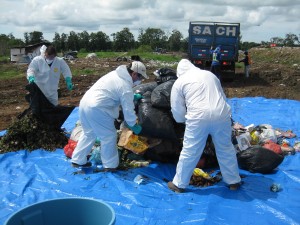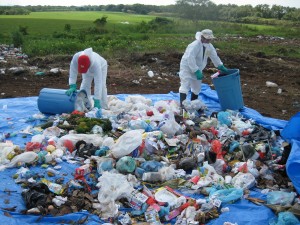The upsurge of concern about pollution caused by plastics has led to great dialogue with waste handlers around the world. The multi-million tonnes of bottle caps, containers, retired fish nets and other non-recyclable plastics are ideal for clean conversion to fuel via the BOS technology. After recycling it makes sense not to send these harmful materials to landfill – not only are they toxic they also have a remarkably long life span after use. So talk to us if you are wrestling with the disposal or management of non-recyclable plastics – together we can use them as fuel for clean energy.

Archive
Archive for the ‘News’ Category
Plastics = Fuel
Tuesday, November 29th, 2011New alliances bring projects to life
Monday, October 31st, 2011The WTEC team are delighted to be working diligently with strategic partners in our core markets. These include Energy Gap in the UK; EPC’s such as Mace, Worley Parsons, Costain and Parsons Brinckerhoff. We’re also working with Cadence, Revlon and Canada’s Export Development Corporation (EDC) and others for project financing solutions.
An Agile platform
Tuesday, September 20th, 2011The BOS technology that WTEC deploys and operates is unique in being an agile system for cleanly converting waste into valuable energy. Unlike more rigid systems BOS can be adapted in a decentralized model for:
- variable waste characteristics
- variable moisture characteristics
- batch system with variable number of trains
- variable configuration – e.g. one power island per 2/3/4/5/ or more trains, plus variable redundancy requirements.
Ask us more about the system by emailing info@wtecanada.com
WtEC to clean Russian toxic sites
Thursday, July 7th, 2011Dzerzhinsk, Russia – Toxic sea to be cleaned – energy produced.
The federally appointed agency responsible for cleaning and remediating two of the world’s most toxic sites chooses a Canadian solution. In a landmark decision the Dzerzhinsk Chemical Cluster has committed to a multi-year remediation and waste to energy agreement with Waste to Energy Canada.
WTEC has been active in domestic and international markets recently with exclusive signatures on binding LOI’s with the Dzerzhinsk Chemical Cluster for two waste to energy plants and an extensive remediation project for two toxic sites known locally as the White Sea and Black Hole in central Russia collectively voted in the world’s top ten most polluted sites. From 1930 to 1998 the sites were unlawfully used for dumping waste produced at chemical plants and now the team responsible for clean up is deploying a solution.
These multi-year projects will ensure WTEC has a strong foothold for future growth in the industrial heartland of Russia. “We have secured these extensive projects based on merit and an excellent relationship with our Russian counterparts in regional government. The issues are clear, the challenge is extraordinary and we have the team and resources to deploy and help solve a world scale environmental issue” says WTEC President Alistair Haughton. “We are grateful to the fine support of the Canadian Department of Foreign Industry and Trade and Export Development Canada, and must reiterate the excellent dialogue with the Chemical Cluster partners to ensure transparency as a key element in success”.
The project involves complete multi-year remediation of the two huge sites and the clean conversion of residual materials into usable thermal energy via WTEC’s waste to energy technology. The first step commences in July 2011 with WTEC designing the waste to energy facility. “The challenge is truly remarkable yet the process is straight forward in that the resulting thermal energy will feed boilers and their steam will augment supply to two local power plants” comments Haughton, “We are delighted to form a long term relationship with the DCC to provide long term renewable baseload electricity supply for the Dzerzhinsk and Nizhny Novgorod region, build a production facility for waste to energy plants while ensuring the environmental clean up of these infamous sites”.
The DCC comprises leaders from government, academia, science, the military and industry professionals who collectively have formed an organization mandated federally and fully committed to ensure the complete remediation of the sites.
Significantly this is only one such program for WTEC as they have also signed binding Front End Engineering agreements with three cities in Volga industrial area of Tartarstan to build, co-own and operate waste to energy plants to provide steam to industry and baseload electricity to the local grid.
These agreements in Russia are the culmination of 12 months rigorous due diligence, meetings at the Canadian Embassy in Moscow and the WTEC team site visits at each Russian location to commence activity on 200mtpd plants converting a wide range of unprocessed municipal, commercial, industrial and hazardous waste. Arrangements with UK based engineering, procurement and management consultants Mace and Parson Brinckerhoff are underway as WTEC secures the best strategic partners for deployment.
The technology WTEC deploys is a long proven two stage thermal gasification/oxidation that has satisfied the rigorous due diligence of EU, Canadian and Russia clean technology scrutiny by approving authorities, emissions regulators and EPC consultants.
Waste to Energy = strategic energy certainty
Wednesday, April 13th, 2011We’ve been involved with numerous national, regional and local policy makers in recent months and there’s a common thread. All seek to solve waste disposal and pollution issues, and some are seeing waste to energy as part of their strategy to achieve strategic energy supply certainty. This means WTE is being placed alongside solar, wind and energy efficiency as key elements in strategies to reduce reliance on and costs of imported fossil fuels. As the emerging markets expand and oil prices climb Waste to Energy is becoming even more viable. Even with improved recycling in some markets waste supply is increasing and has no supply issues related to weather – this consistency helps provide strategic energy certainty and we’re happy to share what we’ve learned with your government, NGO or private sector leaders.
Luxury Resort Deploys WTEC H20 Equipment
Monday, January 17th, 2011After extensive consultations with the WTEC team the ultra-luxury wilderness retreat of Clayoquot Wilderness Resort has announced it’s deployment of an H20 Innovations innovative waste water treatment plant. The resort is located in the World Heritage Site of Clayoquot Sound on Vancouver Island’s rugged west coast, close to Tofino and has been at the forefront of genuinely sustainable operations since it’s inception. Once the new plant is deployed guests will be able use normal bathroom facilities and yet the resort will produce clean treated wastewater introduced back to the aquifer. “We’re excited here, this is another step for us to keep evolving as a leading sustainable resort” said John Caton, Managing Director of Clayoquot Wilderness Resort. See http://www.wildretreat.com/
WTEC & EMISPEC
Wednesday, November 3rd, 2010WTEC and Quebec-based EMISPEC’s history of working together has taken a further step as our teams work on a series of waste to energy facilities for industry, municipalities and government installations. ![]()
EMISPEC partners with WtEC to bring waste to energy to reality and characterizes energy profiles for industrial sites, conducts feasibility studies, designs thermochemical conversion systems and implements biomass to energy projects. These include feasibility studies for:
- Implement, within an aluminum smelter, a gasifier system producing syngas to fuel an anode bake furnace
- Characterization of thermal heat requirements (steam) for a sawmill
- A 600 KW steam turbine for electrical cogeneration in a sawmill
- A 3000 KW steam turbine for electrical cogeneration in a paper plant
- A biomass boiler system in tomato greenhouse complex
- A gasifier coupled to an internal combustion engine for cogeneration from biomass
- A gasification system fuelled from MSW for cogeneration power
Waste Stream Characterization – Panama
Tuesday, October 19th, 2010The WTEC team were active in Panama recently. The research crew completed our comprehensive Waste Stream Characterization Study as a component of the Preliminary Engineering Design Study for one of four new BOS Waste to Energy facilities.
The week-long study samples a waste stream by extracting feedstock samples from non-duplicating loads from non-duplicated collection routes. Each sample is sub-categorized and logged based on weight, volume and percentage of daily sample. A total study representative sample is then used to determine calorific value of the waste as a ‘fuel’ for the BOS waste to energy facility.
Please contact us if you have any questions about the Waste Stream Characterization Study.
What waste?
Friday, July 30th, 2010We are frequently asked what waste BOS and COR systems can convert in to useful energy. While unsorted municipal waste is the most common feedstock, BOS™ systems handle a diverse range of waste streams including municipal, commercial, medical, construction, demolition, Haz Mat, liquid, tires, treated sewage sludge, animal/fish remains, flare gas, industrial and process waste, facility-generated waste streams from mines, oil fields, military, ports, prisons, airports, hospitals, resorts, commercial, industrial or other installations.
The COR™ plants continuously convert more uniform feedstock, such as agricultural, tobacco or wood waste, into usable energy.
Waste to energy building momentum
Thursday, July 15th, 2010Momentum is building in the waste to energy sector and our team’s are active in the global waste-to-energy market which is expected to reach US$28.8 billion by 2015.
Waste-to-Energy technology such as the BOS and COR systems are genuinely sustainable and a cost-efficient method of converting waste into energy - we are emerging as a key component of integrated waste management strategies across the globe.
The strategic need for domestic energy solutions has increased the number of government calls at all levels across the globe for further use of renewable energy. By using WTEC’s waste to energy systems we help create energy independence, reduce landfill pressure, remove non-recyclable wastes and reduce greenhouse gas emissions.
We have noted increased activity in developed countries, which produce higher percentage of waste in comparison to developing nations. Currently Europe dominates the world Waste-to-Energy market with waste diversion targets set by the EU Landfill Directive, rising oil prices, and ongoing demand growth for power being growth drivers.
Developing nations represent fast growing markets for us as well with the adoption of our technology as a sustainable alternative to disease laden landfills or primitive waste incineration in addition to the creation of valuable energy.



